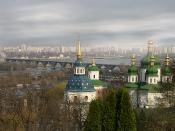The Culture of
Ukraine
The Ukrainian people have made a spirited effort to preserve
their cultural heritage. There are several outdoor museum villages
which display buildings, craft, and living conditions of the past
century. Folk dancing and music festivals are often held with
traditional, regional music and costumes.
The theater scene in Ukraine is pretty lively. Performances
are mostly in Russian or Ukrainian. The Kyiv Opera House is the
home to many opera and ballet companies of considerable talent
and with extensive repertoires. Government subsidies make opera
and theater broadcasts less expensive. The Kyiv Philharmonic
Concert Hall, a nineteenth century church with a pipe organ, and
the Kyiv Opera House have a scheduled program that includes
performances by the Odessa Philharmonic Orchestra.
Ukrainian contemporary art includes painting and sculpture
in a wide range of both experimental and traditional styles. note:
Are you noticing that, like practically every other cultural report,
this paper is giving you the impression that, if you didn't know
any better, Ukraine would still be in the eighteenth century, and I
don't remember any ugly municipal parking garages in the
eighteenth century, and therefore this paper is not entirely
accurate. Icons and folk arts are portrayed in museums, and
contemporary versions are skillfully done and can be purchased in
art galleries and shops. There are several art museums in Kyiv as
well as a Kyivian history museum. There are house museums
containing Ukrainian and European art. The former Lean
Museum, now referred to as the Ukrainian National House, uses
its exhibition space to display numerous small exhibits. In addition
to art, many museums have collections and exhibits on botany,
zoology, geology, archaeology, and aerospace. How the Ukrainian
government fits approximately fifty-three million people in with
all those museums and concert halls is a great demographic
miracle.
Eleven years of schooling are mandatory in Ukraine, so the
secondary school system is a matter for the government. Schools
are state run, (Of course they're state run. Did you ever see a
government program that was privately run?) and deviation from
the curriculum established by the Ministry of Education is
frowned upon. The objective of the secondary schools is to give
students a good knowledge of the fundaments of the arts and
sciences, as well as to teach them to use these fundaments
properly.
Students begin schooling at age six. Because there are no
individual buildings for elementary, junior high, and high schools,
students remain in the same building until they graduate.
After the ninth grade students have the option of entering a
technical school program. These can last from one year (if the
student enters after graduating from secondary school) to three
years (if the student enters after ninth grade). Entering a college or
university in Ukraine is very competitive in Ukraine. Applicants
must produce a certificate of graduation from a secondary school
and to pass difficult examinations. I mean the kind of
examinations that would make the Graduate Record Exam look
like a two-year-old putting together blocks.
Educational policy favors the study of science and
technology. Kyiv is rich in institutes of higher learning. Mohylo
Academy is a private liberal arts university recently built on the
site of Ukraine's first university, which was founded in the
seventeenth century. Among the other new facilities is a school of
law that offers courses in both Ukrainian and English. There are
many American graduate students studying in Ukraine under a
program administered by the International Research and Exchange
Board (IREX) program. Professors from the United States conduct
courses in American literature (an near-oxymoron) and other
subjects under the Fulbright program.
The switch from labor to leisure in Ukraine is not as planned
as in other countries. Ukrainians generally work as hard at one
task as possible so that they needn't try again.
There are a variety of ways Ukrainians do spend their leisure
time. One popular way is to combine the relaxations of drinking,
eating, singing, and get some fresh air. This is also known as
going to a picnic to get drunk, after which you eat enough chili to
give all of southeast Asia heartburn. If you can obtain tickets,
movies, ballets, and plays are a favorite weekend diversion.
Sports complexes can be found in nearly every major city in
Ukraine. These complexes usually house a swimming pool,
facilities for aerobics, boxing, and team sports. There are sports
academies for students, or they may use their own school facilities.
But if none of the above is available, a grassy surface in a park
will suffice. Adults also take part in amateur competitive sports.
Their most popular sports are soccer (with good reason),
basketball, volleyball, hockey, and boxing. Tennis is slowly
gaining popularity, and the Ukrainians have again proven their
intelligence, for there are no golf courses in all of Ukraine.


